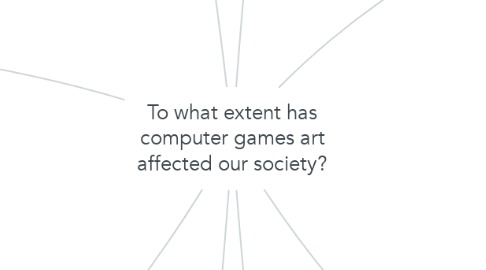
1. Themes
1.1. Psychological
1.1.1. Games used as an outlet.
1.1.2. Games created as psychological experiments.
1.1.3. Used to support child therapy.
1.2. Social
1.2.1. Simulating communication practice in VR.
1.2.2. Effects of gaming on social needs.
1.2.3. Representation of people from different backgrounds.
1.3. Physical
1.3.1. Games used as rehabilitation tools.
1.3.2. Game positively effecting learning.
1.4. Educational
1.4.1. Teach critical thought and analysis.
1.4.2. Used to support learning - reinforce ideas.
1.5. Economical?
1.5.1. Games companies in the UK.
1.5.2. Effect of Brexit?
1.5.3. Used as work training.
1.5.3.1. KFC VR
1.5.4. Promote sustainabulity
1.5.4.1. Environmental
2. Points of View
2.1. Psychological
2.1.1. +
2.1.1.1. Games used to reinforce ideas established in therapy.
2.1.1.2. Players develop critical thinking skills
2.1.1.3. Games created as psychological experiments.
2.1.1.4. Gamification of difficult topics to inform.
2.1.2. -
2.1.2.1. Computer games 'addiction'
2.1.2.2. Implications of violent video games.
2.2. Social
2.2.1. +
2.2.1.1. Opportunity to form friendships.
2.2.1.2. Learn teamwork and communication skills.
2.2.2. -
2.2.2.1. Negative stigma associated with gamers being anti-social.
2.3. Physical
2.3.1. +
2.3.1.1. Games used to rehabilitate those with injuries.
2.3.1.2. Motion-based games get players active.
2.3.2. -
2.3.2.1. Users playing games for long periods of time, may become unhealthy.
2.3.2.2. Poor posture.
2.4. Educational
2.4.1. +
2.4.1.1. Educational games can support learning, reinforce ideas.
2.4.2. -
2.4.2.1. Young children who play games for long hours may suffer educationally.
3. Objectives
3.1. Show a varied viewpoint, what are the negative and positive implications.
3.2. Explore the varied applications of computer games.
3.3. Avoid biased sources.
3.3.1. Games Forums
3.3.2. Game-based Magazines
3.4. Create graphs and visual information to show findings.
3.4.1. Map of Projects in the UK
3.4.1.1. Make project specific to the UK?
3.5. Reference a variety of games
3.5.1. Society
4. Title Variations
4.1. Incite change.
4.1.1. Incite change in the UK?
4.1.1.1. Limits research scope.
4.2. Impact society?
4.3. Impact young people?
4.3.1. Lots of research focused on this,
4.4. Impact a particular topic?
4.4.1. Pyschology
4.4.2. Social
4.4.3. Education
4.4.4. Physical
4.4.5. Economic
4.5. Stylized art
4.5.1. Benefits of different art styles
4.5.2. More appealing to young children
4.5.3. Having friendly art to deliver difficult topics.
4.5.3.1. Provides a good contrast.
5. Resources
5.1. Online
5.1.1. Research Councils
5.1.1.1. RCUK gateway.
5.1.2. Questionnaires
5.1.2.1. Look at data from pre-existing research.
5.1.2.2. Post custom made one online.
5.1.2.2.1. Need to identify an area for focus.
5.1.3. Blogs
5.1.4. News Articles
5.2. Traditional
5.2.1. Journals
5.2.2. Books
5.2.3. Articles
5.2.4. Reviews
5.2.5. Interviews
6. Relation to Pathway
6.1. Virtual-Reality environments.
6.2. Technical Art
6.3. Cinematics
6.4. 2D
6.4.1. Graphical Design
6.4.2. UI
6.4.3. Concept Art
6.5. Games as Art
6.5.1. Walking simulators.
6.5.2. Exhibition pieces.
7. What to Include
7.1. Introduction
7.1.1. Why I chose this topic
7.1.2. Relation to pathway
7.1.3. Personal interest
7.1.4. Summary of content
7.2. Games as Art
7.2.1. Comparison to traditional art forms
7.2.2. Outlining what is art?
7.2.3. Are games considered an art form?
7.2.4. Outlining forms of games art.
7.2.4.1. Games used more in educational settings to reinforce ideas.
7.3. Main Body
7.3.1. Social benefits out weigh the negatives.
7.3.1.1. Gamification used to inform about difficult subjects. e.g. mental health, ethical issues - sweatshop serious game.
7.3.2. More opportunities/funding for research in games.
7.3.3. Companies choosing to work in the UK.
7.4. Investigation
7.4.1. Graphs
7.4.2. Statistics
7.4.2.1. Pre-exisiting
7.4.2.2. Carry out surveys.
7.5. Analysis
7.5.1. Research
7.5.1.1. Pre-existing
7.5.1.2. Funded projects
7.5.2. Themes
7.5.2.1. Some more positive/negative than others?
7.5.2.2. Back up findings with studies.
7.6. Conclusion
7.6.1. Positive and Negative fiindings
7.6.1.1. Extent of this.
7.6.2. Summary of findings
7.6.3. Re-iterate the question
8. Types of Art
8.1. Hand-painted
8.2. Hyper-realism
8.3. Stylized
8.4. 2D
8.4.1. Graphical Design
8.4.2. UI
8.4.3. Concept Art
8.5. Cinematics/Cutscenes
8.6. 'Programmer art'
8.6.1. Serves its purpose.
